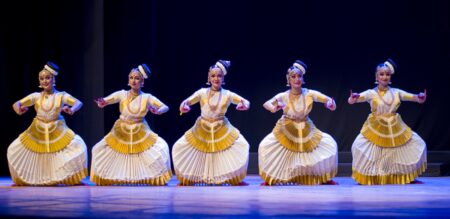The Covid 19 has prompted dance artistes to go online like never before. A look at its good and bad effects, going by experiences of watching the videos so far.
Covid-19 has changed people’s habits, routines and ways of performing tasks the world over. From March 2020, it was a sudden standstill for all endeavours because of a ‘lockdown’. The shut life affected people across social classes, vocations and the arts. There was an immediate shift of all human pursuits to ‘online’. Classical dance arena of India was no exception.
Pre-scheduled festivals and dance concerts got cancelled during the initial days of lockdown. Classical dancers were very quick in their action to turn to virtual platforms. Adapting themselves to the new normal, they began to perform. This opened up new space for discussions, workshops and festivals as well. They found social-media spaces as an alternative platform to express their talent, thereby reconnect with the public.
At the start, the younger generation explored online opportunities. The senior group followed, preparing themselves to handle the gadgets. It was the need of the hour; an omnipotent channel to reach the public mass. Within a few months, various social-media applications saw varied kinds of dance performances uploaded and viewed online. Artistes hitherto inactive in social media also started to create their footprints online.
When performance-art goes online, a few questions arise.
- Are these alternative spaces redefining the aesthetic perceptions of spectators?
- Can they stand only to publicize the artiste, or will they contribute to cultural enrichment in any way?
- Do these new spaces engender a finer class of commentators and rasikas to the dance field?
A re-reading of the online performance tradition is significant. It even determines a link to the future of the arts and artists.
Dancing online during a pandemic
The major types of virtual performances on popular social networking sites such as Instagram and Facebook were live streaming, random video posting and a special production for YouTube channels. Dancers also engaged in classes and talks. The initial efforts of cultural organizations were posting performance contents from archives. This instantaneously turned to the concept of going live. Facebook and Instagram became customized virtual performance platform.
Rather than individual performances by artistes on their pages, it took shape as a dance festival via the official pages/groups of the team. The major organizers of live performance streaming/online dance festivals were cultural societies, dance institutions, temples (festival organizers) and artistes’ groups. Cultural societies and programme organizers offer a complete festival through live streaming including concerts and forums — and managed to pool in personalities. These turned out to be different theme-based, concept-based or style-based festivals.
Random video posting has been another practice. It helps blur the lines of hierarchy among performers. Suddenly, performance videos flooded Facebook and Instagram. Dancers, particularly youngsters, mandatorily recorded and post their videos: random performances, choreographies for a particular piece of audio, compilation of the pieces for a popular song or dancing for prayer songs to fight the pandemic. The younger generation seemed more interested in such efforts. There was no unique way of doing this exercise. Anybody could post different qualities of videos, recorded casually, to show they are dancers. Social-media consumers welcomed any kind of video. None invited serious discussions or scholars’ notice.

Unlike the casual video posts on social networking sites, a few productions by established performers express the concerns of the dancers towards society, as they were meant to spread awareness. The wide circulation and viewership from the general public help performers to be identified among others, especially for mediocre dancers. The hike in the number of views depended upon the performer’s celebrity value and the endorsement by others, mostly celebrities.
Tradition of virtual dance
Classical dance forms are generally meant for an audience. Live vibes were central to such stage performances. The base of performance aesthetics is on experiencing the rasa, which happens with the communion of performer and spectator. The entire space and the overall ambience also matter. It makes the communication successful and aesthetic. In a virtual space, the performers effectively dance for cameras. Viewers watch the dance performance virtually, anytime anywhere, on their gadgets of varied screen-sizes.
Rendering virtual performances is not a new deed for dancers. Since the time of television media, dancers have been giving performances for the camera without audience presence. Online pieces are an extension of such recorded videos, but informal. The dancing space, background, costume colour, lights, quality of the equipment, etc, bear an unofficial air. They constitute the overall beauty and sometimes awfully spoil the essence of the video.
The performances captured through phone face certain challenges. A few among them are unstable cameras, of different qualities. These affect the performance and result in zero uniformity for performances even in one series of the show. Some artists apply different techniques to overcome barriers. For example, they present abhinaya pieces, sitting in front of the cameras, without moving and set the background to make them visually attractive. However, some performers who had not taken special care on these factors were ill-favoured to the medium. Enabling audience comments during the performances was another fence that prevented the proper flow of the performance.
(To be continued.)



